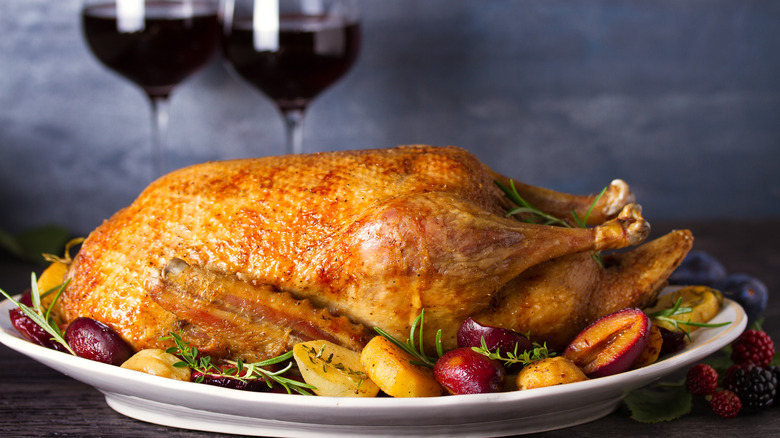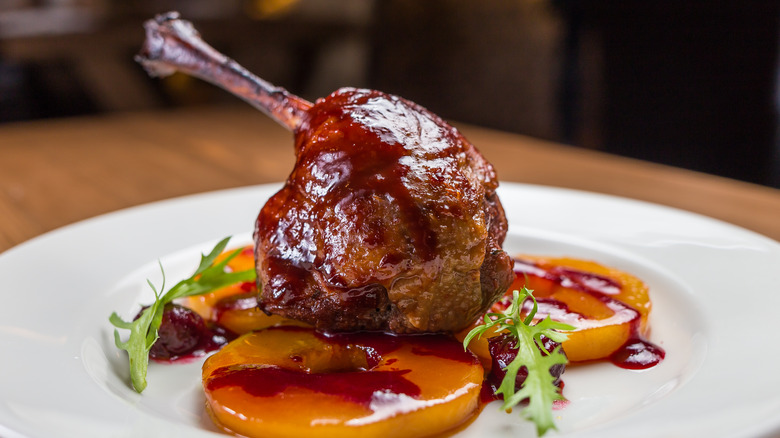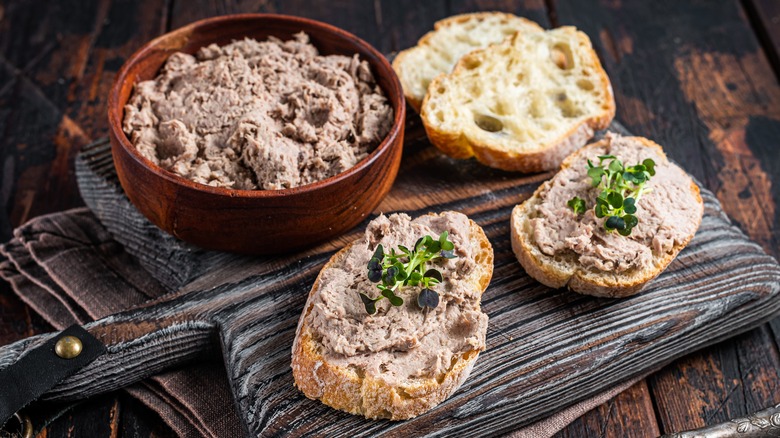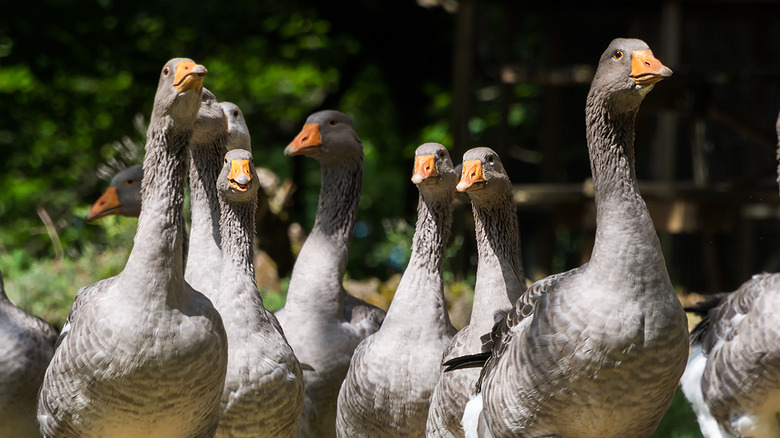The Difference Between Duck Confit And Duck Rillettes
What is it with the French and ducks? Seriously, they really, love ducks. According to the Helgi Library, duck production in France over the last decade has consistently averaged well over 200,000 tonnes. While that's not nearly as many ducks as China, the global leader at well over three million tonnes produced, there is no doubt that French duck recipes are among the most iconic and respected in the entire world.
In France, duck is very much like chicken is here in the United States in that the French consider duck to be a regular part of the diet. However, if there is one quality about ducks that the French are particularly fond of, it's their fat. Basements across the French countryside are lined with cans of glorious duck fat, which is lovingly rendered and preserved for use across a wide variety of dishes. Two classics in particular — confit de canard (duck confit) and rillettes de canard (duck rillettes) — make optimum use of this waterfowl's most prized asset.
Though both confit and rillettes utilize the exact same technique, using fat for flavor and preservation, the resulting dishes are quite different. Duck likes to take its time when cooking. There is absolutely nothing about either of these dishes that are in any way quick, except perhaps the eating. Understanding this cooking and preserving technique can provide a greater appreciation for just how far the French go to make the most out of one of their favorite birds.
Confit de canard
Confit de Canard, or duck confit, is one of the oldest, most well-known of all French recipes that represent a dichotomy. Confit is simultaneously technique and dish. While duck confit may today be considered something of a luxury, it was born out of necessity. In the days before refrigeration, people had to develop ways of preserving their food to last through winter. The confit was one such way, as it lengthened the meat's shelf life by preserving it in its own fat. The family ducks would be butchered at the end of the season and the fattiest portions, the legs, were set aside for making confit.
The preparation and cooking of duck confit is a lengthy, two-step process. First, it's important to salt-cure the meat for at least 24 hours to remove any moisture that could harbor bacteria. Next, you cook the duck legs in melted fat and aromatics on low heat for several hours, until the meat is brown or pulling away from the bone. According to Food Republic, at this stage, the duck legs are arranged in a pot and covered completely in the cooking fat. The duck's fat will solidify around the meat, serving the dual purposes of keeping air from penetrating and causing contamination, and continuing to flavor the duck while it sits. At this stage, the confit will keep in your fridge for up to six months, but you can use the meat well before then.
Rillette de canard
Rillettes de Canard cannot be properly explained without first bringing up pigs. The traditional way of making rillettes, according to D'Artagnan, is to slow-cook chopped pork in its own fat. The meat is then salted, shredded, and placed into small pots. A generous layer of the cooking fat is then spread over the top of the packed meat. The purpose of the fat layer is to keep the meat from spoiling when it is stored. This method can be applied to rabbits, chickens, and even fish. However, one of the more popular varieties of rillettes is a duck.
Duck rillettes is an excellent byproduct of making duck confit. While they are separate dishes in their own right, the confit process of cooking the duck legs and thighs in their own fat remains the same. Now that you've got your confit all submerged and stored away, making rillettes is as simple as pulling the legs out of the fat, shredding the meat, adding a little seasoning, and then packing it back into jars. As with classic pork rillettes, a thin layer of duck fat is used to seal the shredded meat. Rillettes will keep in the fridge for up to a month and are excellent for use as an appetizer spread across baguette toasts, (via The Chicago Sun-Times). Don't feel limited by this, however. There is a litany of ways in which you can use rillettes to add a little ducky goodness to your kitchen.
A duck's place
Rounding out this duck fat exposé by ending at the beginning, it is hard to express the true importance that ducks, and, to a certain extent, geese, play in French cuisine. The cooking of Gascony is especially centered around the duck. Ducks feed the masses. They are an integral part of the French family table and are an important example of how to stretch an ingredient to its fullest potential. The French use the whole duck, not merely the attractive cuts like legs or breasts.
French cooking on the whole has had a tremendous influence on the culinary heritage of the West. According to The Auguste Escoffier School of Culinary Arts, French cuisine dominates because of its honed and developed techniques, fresh ingredients, creativity, tradition, and outstanding flavors. Though French cooking continues to evolve with time, the tried-and-true methods endure all the trappings many think come with French cuisine. The French take on duck, for instance, may seem outwardly elegant, but beneath the veneer is a tradition founded on economy and simplicity. There's very little more honorable than that.



